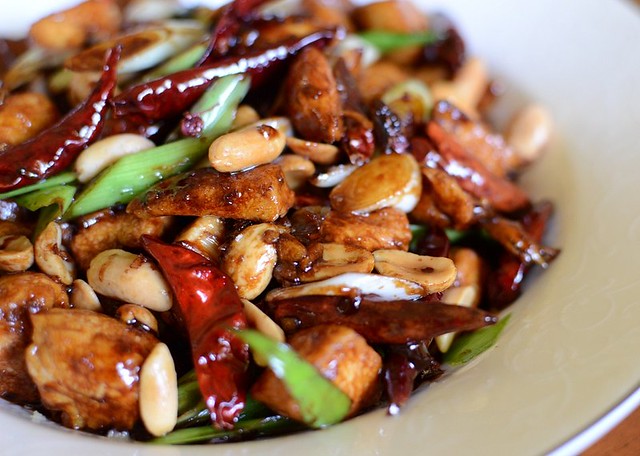
The spicy Sichuan dish gong bao ji ding (Gong Bao's--whoever he was--chicken bits) is equivalent to the Cantonese gu lao rou (sweet and sour pork) in terms of popularity. Chinese restaurants in the USA without fail will have gong bao ji ding, gu lao rou andbeef with black soy beans on their menu.
I used to cook this dish until I taught my MIL who then cooked it so well that I gave up cooking it. Through the years however, MIL's gong bao ji dinghasevolved according to my FIL's taste and she now makes the dish a mild version with lots of soy sauce, Shanghai-style, so recently I started cooking my version again and since she doesn't read my blog, I'll declare that my version is not only better than hers but also better than all the restaurants in this town because theirgong bao ji dingarea black sticky mess of burnt chilies and a few chunks of chicken. Idare say that this recipe is so fool proof that there's no need for tweaking. You just need to know how to fry the ingredients to get them at their best flavor and texture.

Sichuan dried chilies are smaller than our red chilies and much hotter too.
What makes a gong bao ji dingbetter than just good? Firstly, it must not only taste good but look right too. By that I mean the dish must look dark, not pale, and the sauce must be thick, not watery yet not starchy. Secondly, I look chicken chunks that should be small so that there's greater surface area for the sauce to coat and for that, the sauce must be caramelized en! ough to cling to the chicken. If the sauce is thickened mainly by cornstarch, it will not have that caramelized soy sauce flavor and thickness. I do add a very small amount of cornstarch to hasten the thickening but not so much that the sauce is starchy. Thirdly, the chilies--preferably Sichuan dried chilies because they are packed with heat and capsicum fragrance--must be done just right: crispy yet not burnt. I'm not particular about the Sichuan peppercorns; this dish is good even without those numbing explosives. Fourthly, the nuts. Some restaurants, especially the upscale ones, use cashew nuts instead of peanuts. I've tried using cashew nuts but found that the dish is far better with peanuts. This is a dish that you pick at with chopsticks, savoring the sauce-covered chicken or leeks or nuts and perhaps washing them down with a cold beer. Cashew nuts just fill the stomach up too quickly compared to peanuts. Finally, the chicken. Even when you get the sauce right, you fail if the chicken turns out tough or dry. To make sure that doesn't happen, marinade the chicken in egg white and cornflour a few hours ahead of cooking and do not overcook. I like to use chicken breasts for this dish because they are very tender when cooked right.
Gong bao ji ding is best piping hot and I like to cook it when my guests are seated at the table. It's a simple dish but you may need to practice cooking it before it's perfect.

Gong Bao Ji Ding
250 gm skinless chicken breast (one side of a large breast)
3/4 cup dried chilies (if big, cut into 3 cm lengths)
1 t Sichuan peppercorns (optional)
3/4 cup leeks, cut diagonally about 2 cm long
1 large handful (50 gm) fried peanuts
2 t finely chopped garlic
2 t finely chopped ginger
Chicken marinade:!
2 t cornflour
1 small egg white
a few shakes of white pepper
2 T rice wine
a pinch of salt
The sauce:
1/2 T white rice vinegar
1 1/2 T black soy sauce (Lee Kum Kee is good)
1 1/2 T castor sugar
1 1/2 T chicken stock or water
1/2 t cornflour
--mix all the sauce ingredients together until the sugar is dissolved
1. Cut the chicken breast into small chunks, about 1.5 to 2 cm square. Massage marinade into the chicken with your hands, cover and leave in fridge for at least 1 hour.
2. Heat 1 cup veg oil in a wok, add the chicken and spread it out into a single layer. When chicken has turned white at the sides (high heat), turn over and stir. Do not overcook. I check by cutting one piece of chicken with the frying ladle. It should take about 1 minute only, less if the fire's very hot. Remove chicken onto a plate, leaving the oil in the wok.
3. Pour away the oil into a metal or ceramic bowl until about 3 T is left in the wok.
4. Fry the chilies, in very low heat, until crisp but not burnt (be careful, dried chilies burn quickly). Remove. Pour away all the oil because it is chili-hot. You can keep the chili oil for other dishes.
5. Add 1 to 2 T of the oil used for frying the chicken to the same wok (this IS a greasy dish; be brave) and add the garlic, ginger and Sichuan peppercorns if using. Throw in the leeks, stir until they turn bright green, then pour in the sauce, stirring all the time. The heat is at high. When the sauce is very dark and thick, add the chicken and stir quickly, then add the peanuts and dish up. That's it. Serve straightaway.
No comments:
Post a Comment